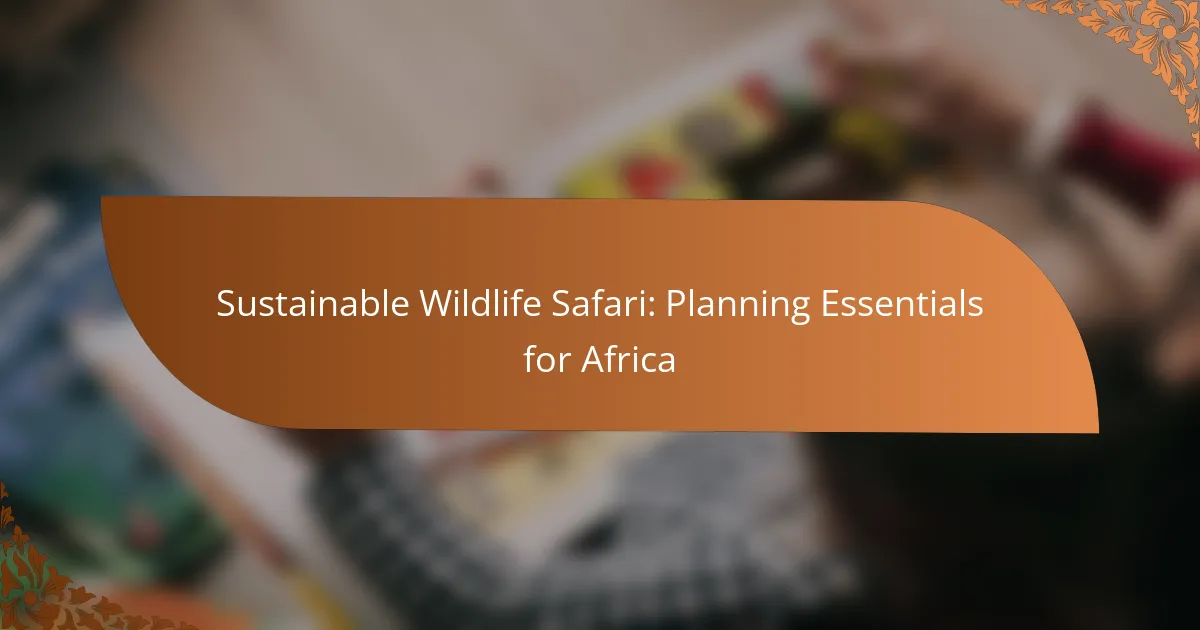Embarking on a sustainable wildlife safari in Africa offers a unique opportunity to experience the continent’s breathtaking biodiversity while supporting conservation efforts. By choosing operators that prioritize environmental responsibility and community engagement, you can ensure that your adventure contributes positively to both wildlife preservation and local economies. Careful planning of your itinerary, including destination selection and timing, will enhance your experience and maximize wildlife encounters.

How to Choose a Sustainable Wildlife Safari in Africa?
Choosing a sustainable wildlife safari in Africa involves selecting operators that prioritize conservation and community engagement. Look for tours that minimize environmental impact and support local economies, ensuring your adventure contributes positively to wildlife preservation.
Top eco-friendly safari operators
Some of the leading eco-friendly safari operators include Wilderness Safaris, &Beyond, and EcoTraining. These companies are known for their commitment to sustainable practices, such as using renewable energy sources and supporting local conservation efforts.
When selecting an operator, check for certifications from recognized organizations like the Global Sustainable Tourism Council (GSTC) or the Rainforest Alliance, which indicate adherence to high sustainability standards.
Criteria for sustainable practices
Key criteria for sustainable practices in safari operations include minimizing carbon footprints, promoting wildlife conservation, and engaging with local communities. Operators should implement measures like reducing waste, using eco-friendly transportation, and ensuring that a portion of profits supports conservation projects.
Additionally, consider how the safari impacts local wildlife. Sustainable operators often limit group sizes and avoid sensitive habitats during peak seasons to reduce disturbances to animals.
Best destinations for eco-safaris
Some of the best destinations for eco-safaris in Africa include Botswana’s Okavango Delta, Kenya’s Maasai Mara, and Tanzania’s Serengeti. These regions not only offer stunning wildlife experiences but also have numerous eco-lodges and camps that practice sustainable tourism.
In South Africa, Kruger National Park and surrounding private reserves are excellent choices, featuring eco-friendly accommodations and responsible wildlife viewing practices. Always research the specific lodges and operators in these areas to ensure they align with your sustainability values.

What Should You Pack for a Wildlife Safari?
Packing for a wildlife safari requires careful consideration of both clothing and gear to ensure comfort and safety in diverse environments. Essential items will help you adapt to varying weather conditions and maximize your experience while observing wildlife.
Essential clothing items
When selecting clothing for a wildlife safari, prioritize comfort and practicality. Lightweight, breathable fabrics are ideal for warm days, while layers are crucial for cooler evenings. Neutral colors like khaki, olive, and brown help you blend into the environment and avoid startling animals.
Consider packing a wide-brimmed hat, sunglasses, and a good pair of binoculars. Sturdy, comfortable footwear is essential for walking and exploring, so opt for closed-toe shoes or hiking boots. Don’t forget to include a waterproof jacket in case of unexpected rain.
Recommended gear and equipment
In addition to clothing, certain gear and equipment can enhance your safari experience. A high-quality camera with a zoom lens is invaluable for capturing wildlife moments. Bring extra batteries and memory cards to ensure you don’t miss any opportunities.
A daypack is useful for carrying essentials like water, snacks, and a first-aid kit. Consider a reusable water bottle to stay hydrated and reduce plastic waste. Lastly, a flashlight or headlamp can be handy for nighttime activities or navigating your campsite.

How to Plan Your Safari Itinerary?
Planning your safari itinerary involves selecting the right destinations, timing, and activities to maximize your wildlife experience. Consider factors such as popular routes, wildlife viewing seasons, and the duration of your trip to create a fulfilling adventure.
Popular safari routes in Africa
Africa offers a variety of popular safari routes, each providing unique wildlife experiences. Notable routes include the Serengeti in Tanzania, known for its annual wildebeest migration, and Kruger National Park in South Africa, famous for its diverse ecosystems and the Big Five.
Other routes worth considering are the Maasai Mara in Kenya, which features stunning landscapes and rich wildlife, and Chobe National Park in Botswana, known for its large elephant population. Researching these routes will help you choose the best fit for your interests.
Wildlife viewing seasons
Wildlife viewing seasons vary across Africa, with the dry season typically offering the best opportunities for spotting animals. In many regions, such as East Africa, the dry months from June to October are ideal for game viewing as animals congregate around water sources.
Conversely, the wet season, from November to May, can provide lush landscapes and newborn animals, but wildlife may be more dispersed. Understanding these seasonal patterns will enhance your chances of experiencing memorable wildlife encounters.
Duration of safari trips
The duration of safari trips can range from a few days to several weeks, depending on your interests and budget. A typical safari lasts about 5 to 7 days, allowing ample time to explore multiple parks and engage in various activities.
For a more immersive experience, consider extending your trip to 10 days or more, which enables you to visit additional locations and participate in guided tours or cultural experiences. Be mindful of travel times between destinations, as they can impact your overall itinerary.

What Are the Costs Involved in a Safari?
The costs involved in a safari can vary significantly based on factors such as location, duration, and type of experience. Generally, travelers should budget for accommodation, park fees, transportation, and guided services, which can add up to a substantial total depending on the choices made.
Average safari package prices
On average, a safari package can range from around $150 to over $1,500 per person per day. Budget safaris typically offer basic accommodations and fewer amenities, while luxury options provide high-end lodges and exclusive experiences. It’s essential to consider what is included in the package, as this can greatly affect the overall cost.
For example, a mid-range safari in Kenya might cost between $300 and $600 per day, including meals, guided tours, and park entry fees. In contrast, a luxury safari in Tanzania could exceed $1,000 per day, offering gourmet dining and private guides.
Cost breakdown by safari type
The cost of a safari can vary based on the type of experience chosen. Guided safaris, which include a professional guide and often cover multiple parks, tend to be more expensive than self-drive options. Guided tours can range from $200 to $800 per day, depending on the level of service and the number of participants.
Camping safaris are generally more budget-friendly, with costs ranging from $150 to $300 per day. These often include shared facilities and meals, making them a popular choice for travelers looking to save money. In contrast, private luxury safaris can start at $500 and go well above $2,000 per day, offering personalized experiences and premium accommodations.

What Are the Benefits of Sustainable Safaris?
Sustainable safaris provide significant advantages by promoting environmental conservation, supporting local communities, and ensuring the protection of wildlife. These benefits create a more responsible travel experience that contributes positively to Africa’s ecosystems and cultures.
Conservation impact
Sustainable safaris play a crucial role in conservation by funding wildlife reserves and protecting natural habitats. Tour operators often allocate a portion of their profits to conservation projects, which can include anti-poaching initiatives and habitat restoration efforts.
Travelers can contribute to these efforts by choosing operators that prioritize eco-friendly practices, such as minimizing waste and reducing carbon footprints. This ensures that tourism revenue directly supports the preservation of Africa’s unique biodiversity.
Community involvement
Community involvement is a cornerstone of sustainable safaris, as they often engage local populations in tourism activities. This can include hiring local guides, sourcing food from nearby farms, and involving communities in decision-making processes regarding land use.
By supporting local economies, sustainable safaris help reduce poverty and empower communities, fostering a sense of ownership over natural resources. This collaboration enhances cultural exchange and promotes respect for local traditions.
Wildlife protection efforts
Wildlife protection efforts are integral to sustainable safaris, focusing on the preservation of endangered species and their habitats. Many safari operators partner with conservation organizations to monitor wildlife populations and implement protective measures.
Travelers can actively participate in these efforts by choosing tours that emphasize ethical wildlife viewing practices, such as maintaining safe distances and avoiding activities that stress animals. This approach not only safeguards wildlife but also enriches the safari experience through responsible interactions with nature.

How to Ensure a Responsible Safari Experience?
To ensure a responsible safari experience, prioritize ethical practices that protect wildlife and their habitats. This involves choosing reputable tour operators, adhering to guidelines for wildlife interactions, and being mindful of environmental impacts.
Guidelines for ethical wildlife interactions
Engaging with wildlife responsibly is crucial for their conservation and well-being. Always maintain a safe distance from animals, avoiding any actions that could stress or harm them. Use binoculars or cameras with zoom lenses to observe without intruding.
When on safari, follow the instructions of your guide, who is trained in animal behavior and conservation practices. Do not feed wildlife, as this can alter their natural foraging habits and lead to dependency on human food.
Consider supporting local communities by choosing tours that contribute to conservation efforts. Look for operators that invest in wildlife protection and community development, ensuring that your safari benefits both the environment and local people.
